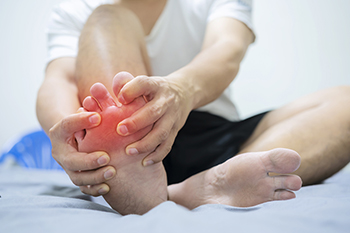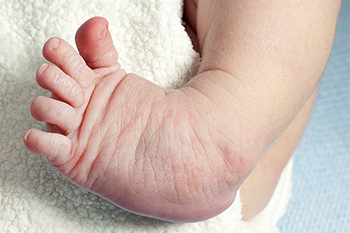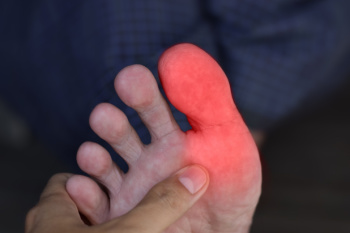Items filtered by date: March 2024
Joint and Other Damage From Gout

Gout is a form of inflammatory arthritis caused by the buildup of uric acid crystals in the joints, leading to sudden and severe pain, swelling, and redness, often affecting the big toe. Over time, repeated gout attacks can result in joint damage, deformity, and chronic arthritis. The accumulation of uric acid, a waste product normally excreted by the kidneys, can be attributed to various factors, including genetics and a diet that is high in purines found in red meat, seafood, and alcohol. Additionally, obesity, certain medications and underlying health conditions, such as hypertension and kidney disease, can contribute to developing gout. Lifestyle modifications consisting of maintaining a healthy weight, avoiding purine-rich foods, limiting alcohol consumption, and staying hydrated may help to reduce the risk of developing gout. Failure to manage gout effectively can lead to complications, such as tophi or lumps of uric acid crystals under the skin, kidney stones, and permanent joint damage. If you have gout, it is suggested that you seek medical attention from a podiatrist, adhere to treatments prescribed, and adopt a healthy lifestyle, which are important for preventing and managing gout effectively.
Gout is a painful condition that can be treated. If you are seeking treatment, contact Kenneth Williams, DPM from Texas. Our doctor will treat your foot and ankle needs.
What Is Gout?
Gout is a form of arthritis that is characterized by sudden, severe attacks of pain, redness, and tenderness in the joints. The condition usually affects the joint at the base of the big toe. A gout attack can occur at any random time, such as the middle of the night while you are asleep.
Symptoms
- Intense Joint Pain - Usually around the large joint of your big toe, and it most severe within the first four to twelve hours
- Lingering Discomfort - Joint discomfort may last from a few days to a few weeks
- Inflammation and Redness -Affected joints may become swollen, tender, warm and red
- Limited Range of Motion - May experience a decrease in joint mobility
Risk Factors
- Genetics - If family members have gout, you’re more likely to have it
- Medications - Diuretic medications can raise uric acid levels
- Gender/Age - Gout is more common in men until the age of 60. It is believed that estrogen protects women until that point
- Diet - Eating red meat and shellfish increases your risk
- Alcohol - Having more than two alcoholic drinks per day increases your risk
- Obesity - Obese people are at a higher risk for gout
Prior to visiting your podiatrist to receive treatment for gout, there are a few things you should do beforehand. If you have gout you should write down your symptoms--including when they started and how often you experience them, important medical information you may have, and any questions you may have. Writing down these three things will help your podiatrist in assessing your specific situation so that he or she may provide the best route of treatment for you.
If you have any questions, please feel free to contact our office located in San Antonio and Beeville, TX . We offer the newest diagnostic and treatment technologies for all your foot care needs.
Common Causes of Foot Pain
 Foot pain can occur for many reasons, making it tough to know exactly what is wrong without the help of a medical professional. One common cause of foot pain is a fracture, which is a break in the bones of the foot. This can cause intense pain, making it difficult to walk. Heart disease can also lead to foot problems. This condition makes it harder for blood to circulate properly, leading to swelling and pain in the feet. Diabetes is another big cause of foot pain, because high sugar levels can damage nerves in the feet, causing pain and sometimes even leading to serious infections if cuts or sores do not heal properly. Plantar fasciitis is also common, especially in people who stand for extended periods of time or wear shoes without good support. It happens when the thick band of tissue on the bottom of the foot gets inflamed, causing heel pain that is usually worse in the morning. If you have foot pain, it is suggested that you schedule an appointment with a podiatrist, who can help diagnose the source of the pain and create an effective treatment plan.
Foot pain can occur for many reasons, making it tough to know exactly what is wrong without the help of a medical professional. One common cause of foot pain is a fracture, which is a break in the bones of the foot. This can cause intense pain, making it difficult to walk. Heart disease can also lead to foot problems. This condition makes it harder for blood to circulate properly, leading to swelling and pain in the feet. Diabetes is another big cause of foot pain, because high sugar levels can damage nerves in the feet, causing pain and sometimes even leading to serious infections if cuts or sores do not heal properly. Plantar fasciitis is also common, especially in people who stand for extended periods of time or wear shoes without good support. It happens when the thick band of tissue on the bottom of the foot gets inflamed, causing heel pain that is usually worse in the morning. If you have foot pain, it is suggested that you schedule an appointment with a podiatrist, who can help diagnose the source of the pain and create an effective treatment plan.
Foot Pain
Foot pain can be extremely painful and debilitating. If you have a foot pain, consult with Kenneth Williams, DPM from Texas. Our doctor will assess your condition and provide you with quality foot and ankle treatment.
Causes
Foot pain is a very broad condition that could be caused by one or more ailments. The most common include:
- Bunions
- Hammertoes
- Plantar Fasciitis
- Bone Spurs
- Corns
- Tarsal Tunnel Syndrome
- Ingrown Toenails
- Arthritis (such as Gout, Rheumatoid, and Osteoarthritis)
- Flat Feet
- Injury (from stress fractures, broken toe, foot, ankle, Achilles tendon ruptures, and sprains)
- And more
Diagnosis
To figure out the cause of foot pain, podiatrists utilize several different methods. This can range from simple visual inspections and sensation tests to X-rays and MRI scans. Prior medical history, family medical history, and any recent physical traumatic events will all be taken into consideration for a proper diagnosis.
Treatment
Treatment depends upon the cause of the foot pain. Whether it is resting, staying off the foot, or having surgery; podiatrists have a number of treatment options available for foot pain.
If you have any questions, please feel free to contact our office located in San Antonio and Beeville, TX . We offer the newest diagnostic and treatment technologies for all your foot care needs.
Treatment of Clubfoot

Clubfoot is a congenital deformity characterized by the foot twisting downward and inward, which poses challenges to walking. Clubfoot cannot be prevented. However, it can be effectively addressed through the Ponseti method, which is a cost-effective treatment. The exact cause of clubfoot remains unknown, but in some cases, there are misconceptions that it is due to something the parent did wrong. For example, sometimes mothers are wrongly blamed for the condition, and clubfoot becomes associated with factors like undisclosed sins, curses, or physical strain. These misconceptions underscore the importance of advocacy, educating communities that clubfoot is not preventable through parental behavior. Ultimately, while the causes of clubfoot may remain unclear, its treatment options offer hope and relief for affected individuals. If your child is born with clubfoot, it is strongly suggested that you make an appointment with a podiatrist to get whatever treatment is deemed necessary underway.
Congenital foot problems require immediate attention to avoid future complications. If you have any concerns, contact Kenneth Williams, DPM of Texas. Our doctor can provide the care you need to keep you pain-free and on your feet.
Congenital foot problems are deformities affecting the feet, toes, and/or ankles that children are born with. Some of these conditions have a genetic cause while others just happen. Some specific foot ailments that children may be born with include clubfeet, polydactyly/macrodactyly, and cleft foot. There are several other foot anomalies that can occur congenitally. What all of these conditions have in common is that a child may experience difficulty walking or performing everyday activities, as well as trouble finding footwear that fits their foot deformity. Some of these conditions are more serious than others. Consulting with a podiatrist as early as possible will help in properly diagnosing a child’s foot condition while getting the necessary treatment underway.
What are Causes of Congenital Foot Problem?
A congenital foot problem is one that happens to a child at birth. These conditions can be caused by a genetic predisposition, developmental or positional abnormalities during gestation, or with no known cause.
What are Symptoms of Congenital Foot Problems?
Symptoms vary by the congenital condition. Symptoms may consist of the following:
- Clubfoot, where tendons are shortened, bones are shaped differently, and the Achilles tendon is tight, causing the foot to point in and down. It is also possible for the soles of the feet to face each other.
- Polydactyly, which usually consists of a nubbin or small lump of tissue without a bone, a toe that is partially formed but has no joints, or an extra toe.
- Vertical talus, where the talus bone forms in the wrong position causing other bones in the foot to line up improperly, the front of the foot to point up, and the bottom of the foot to stiffen, with no arch, and to curve out.
- Tarsal coalition, when there is an abnormal connection of two or more bones in the foot leading to severe, rigid flatfoot.
- Cleft foot, where there are missing toes, a V-shaped cleft, and other anatomical differences.
- Macrodactyly, when the toes are abnormally large due to overgrowth of the underlying bone or soft tissue.
Treatment and Prevention
While there is nothing one can do to prevent congenital foot problems, raising awareness and receiving neonatal screenings are important. Early detection by taking your child to a podiatrist leads to the best outcome possible.
If you have any questions please feel free to contact our office located in San Antonio and Beeville, TX . We offer the newest diagnostic tools and technology to treat your foot and ankle needs.
Possible Causes of Painful Toes

Toe health can be connected to overall well-being. Despite this significance, feet are generally not given enough attention. Toe and toenail changes that may signal underlying health issues can include concave toenails, which can indicate anemia or autoimmune disorders, and tingling or numbness, which could be suggestive of diabetes-related neuropathy. Other potential toe issues, such as dark vertical bands or spots, washed out nails, painful and inflamed toe joints, clubbed toes, and cold or blue toes, can each potentially be indicative of different health concerns ranging from melanoma to heart disease. If you have painful toes or notice something not quite right about these appendages, it is suggested that you schedule an appointment with a podiatrist for a proper diagnosis and treatment.
Toe pain can disrupt your daily activities. If you have any concerns, contact Kenneth Williams, DPM of Texas. Our doctor can provide the care you need to keep you pain-free and on your feet.
What Causes Toe Pain?
Most severe toe pain is caused due to a sports injury, trauma from dropping something heavy on the toe, or bumping into something rigid. Other problems can develop over time for various reasons.
Toe pain can be caused by one or more ailments. The most common include:
- Trauma
- Sports injury
- Wearing shoes that are too tight
- Arthritis
- Gout
- Corns and calluses
- Hammertoe
- Bunions
- Blisters
- Ingrown toenails
- Sprains
- Fractures (broken bones)
- Dislocations
When to See a Podiatrist
- Severe pain
- Persistent pain that lasts more than a week
- Signs of infection
- Continued swelling
- Pain that prevents walking
Diagnosis
In many cases the cause of toe pain is obvious, but in others, a podiatrist may want to use more advanced methods to determine the problem. These can range from simple visual inspections and sensation tests to X-rays and MRI scans. Prior medical history, family medical history, and any recent physical traumatic events will all be taken into consideration for a proper diagnosis.
Treatment
Treatments for toe pain and injuries vary and may include shoe inserts, padding, taping, medicines, injections, and in some cases, surgery. If you believe that you have broken a toe, please see a podiatrist as soon as possible.
If you have any questions please feel free to contact our office located in San Antonio and Beeville, TX . We offer the newest diagnostic tools and technology to treat your foot and ankle needs.

